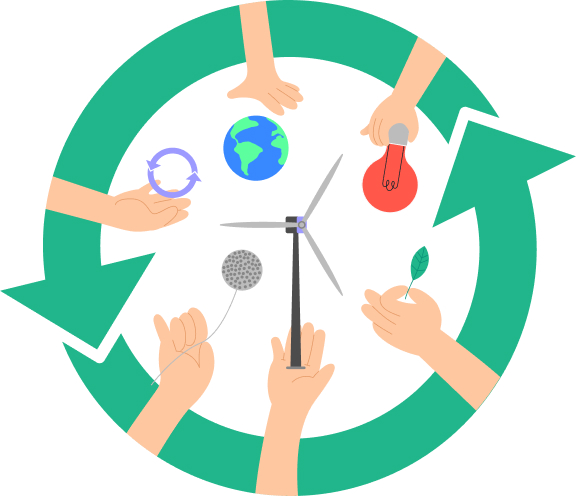Combatting Global Warming through Sustainable Electronics
Global warming refers to the increase in the Earth’s temperature and the release of greenhouse gases like carbon dioxide into the atmosphere. This phenomenon leads to a rise in global pollution levels, significantly impacting people’s lives both now and in the future. For instance, the average temperature has increased by approximately 1.15 degrees over the last decade, from 2013 to 2023, compared to the period between 1850 and 1990. Projections indicate that temperatures may increase by 1 to 5.5 degrees during this century, as per the latest UN report in 2023. This temperature rise is expected to bring about various issues, including food and water shortages leading to famines in different parts of the world. Additionally, coastal areas may face submersion due to rising sea levels caused by the melting of icebergs in the Earth’s polar regions. Consequently, many countries are currently implementing policies to mitigate the effects of climate change and promote eco-friendly practices.

According to the most recent UN report issued in 2022, 53 million tons of electronic waste were discarded in 2019, including unusable electronic devices with reusable raw materials valued at 57 billion dollars. The amount of electronic waste generated is staggering, equivalent to 4500 times the weight of the Eiffel Tower or all commercial airplanes ever built. It is projected that electronic waste will reach 76 million tons by 2030, presenting a significant challenge and contributing to environmental pollution and resource wastage.

My Experience in Electronics
I am currently an Assistant Professor at the George Green Institute for Electromagnetics Research, University of Nottingham, UK. My research focuses on developing electronic devices for various communication applications, particularly in the field of millimeter-wave technology. With over a decade of experience, my interdisciplinary work spans areas like 3D printing, utilizing liquid metals like gallium for innovative device creation, and material sciences for telecommunications devices such as antennas, mm-wave, and microwave-reconfigurable devices. Apart from conducting scientific research, I have authored over 55 peer-reviewed journal articles and international conference papers.
I am currently an Assistant Professor at the George Green Institute for Electromagnetics Research, University of Nottingham, UK. My research focuses on developing electronic devices for various communication applications, particularly in the field of millimeter-wave technology. With over a decade of experience, my interdisciplinary work spans areas like 3D printing,

I am currently an Assistant Professor at the George Green Institute for Electromagnetics Research, University of Nottingham, UK. My research focuses on developing electronic devices for various communication applications, particularly in the field of millimeter-wave technology. With over a decade of experience, my interdisciplinary work spans areas like 3D printing, utilizing liquid metals like gallium for innovative device creation, and material sciences for telecommunications devices such as antennas, mm-wave, and microwave-reconfigurable devices. Apart from conducting scientific research, I have authored over 55 peer-reviewed journal articles and international conference papers.
I am currently an Assistant Professor at the George Green Institute for Electromagnetics Research, University of Nottingham, U.K. My research focuses on developing electronic devices for various communication applications, particularly in the field of millimeter-wave technology. With over a decade of experience, my interdisciplinary work spans areas like 3D printing,

utilizing liquid metals like gallium for innovative device creation, and material sciences for telecommunications devices such as antennas, mm-wave, and microwave-reconfigurable devices. Apart from conducting scientific research, I have authored over 55 peer-reviewed journal articles and international conference papers.


The use of clean and renewable energy sources like solar and wind power is crucial for sustainable electricity provision, combating climate change, and achieving sustainable development, especially in the MENA region. This shift will help lessen the impact of global warming and climate change in the area, meeting most of its energy requirements in the near future, even before the era of oil and gas ends. Both theoretically and practically, the Islamic and Arab regions show great potential for energy self-sufficiency through solar power. Moreover, they can export this energy to various countries worldwide, particularly in the Northern Hemisphere. While the southern states of the US are known as the “US Sun Belt” due to their sunny climate, the MENA region is often referred to as the “Global Sun Belt” because of its extensive sunlight exposure, exceeding 4300 hours annually in most countries.


Moreover, they can export this energy to various countries worldwide, particularly in the Northern Hemisphere. While the southern states of the US are known as the “US Sun Belt” due to their sunny climate, the MENA region is often referred to as the “Global Sun Belt” because of its extensive sunlight exposure, exceeding 4300 hours annually in most countries. Additionally, the region’s capacity to generate more than 2000 kilowatt-hours of solar energy per square meter is impressive. By considering the MENA region’s vast area of over 11 million square kilometers and the global electricity consumption rate of 26500 terawatt-hours in 2022, it becomes evident that the region could meet over 825 times the global electricity demand. For instance, a recent study demonstrated that just 1% of the Arab states in North Africa could produce 12000 terawatt-hours of electricity each year using solar energy, accounting for nearly half of the world’s current electricity demand. [8]-[10]

The use of clean and renewable energy sources like solar and wind power is crucial for sustainable electricity provision, combating climate change, and achieving sustainable development, especially in the MENA region.
Additionally, the region’s capacity to generate more than 2000 kilowatt-hours of solar energy per square meter is impressive. By considering the MENA region’s vast area of over 11 million square kilometers and the global electricity consumption rate of 26500 terawatt-hours in 2022, it becomes evident that the region could meet over 825 times the global electricity demand. For instance, a recent study demonstrated that just 1% of the Arab states in North Africa could produce 12000 terawatt-hours of electricity each year using solar energy, accounting for nearly half of the world’s current electricity demand. [8]-[10]
Recommendations for Transitioning to Renewable
Energy Sources
In the MENA region, policymakers need to create a conducive environment for a complete shift towards renewable energy. This involves more than just setting up new plants; it also means localizing the production of power plant components, enhancing the efficiency of existing components, creating cost-effective and highly efficient energy storage technology, and improving energy transportation and distribution for export purposes. By fostering investment and supporting local companies in developing and manufacturing this technology, the energy sector can become fully localized in these countries. Additionally, these nations and their universities should invest in scientific research to facilitate collaboration between research institutions and the industry sector, enabling universities and academic centers to provide technology and expertise.

In the MENA region, policymakers need to create a conducive environment for a complete shift towards renewable energy. This involves more than just setting up new plants; it also means localizing the production of power plant components, enhancing the efficiency of existing components, creating cost-effective and highly efficient energy storage technology, and improving energy transportation and distribution for export purposes.


In the MENA region, policymakers need to create a conducive environment for a complete shift towards renewable energy. This involves more than just setting up new plants; it also means localizing the production of power plant components, enhancing the efficiency of existing components, creating cost-effective and highly efficient energy storage technology, and improving energy transportation and distribution for export purposes.
In the MENA region, policymakers need to create a conducive environment for a complete shift towards renewable energy. This involves more than just setting up new plants; it also means localizing the production of power plant components, enhancing the efficiency of existing components, creating cost-effective and highly efficient energy storage technology, and improving energy transportation and distribution for export purposes.

[1] retrieved from: https://www.itu.int/en/ITU-D/Environment/Pages/Spotlight/Global-Ewaste-Monitor-2020.aspx
[2] F. Torricelli, I. Alessandri, E. Macchia, I. Vassalini, M. Maddaloni, L. Torsi 2100445, Green Materials and Technologies for Sustainable Organic Transistors. Adv. Mater. Technol. 2022, 7, 2100445. https://doi.org/10.1002/admt.202100445
[3] H. Tu, et. al. “Silk-based resorbable electronic devices for remotely controlled therapy and in vivo infection abatement”, PNAS, Vol. 111, No. 49, Nov. 2014.
[4] J. A. Chiong, H. Tran, Y. Lin, Y. Zheng, Z. Bao, Integrating Emerging Polymer Chemistries for the Advancement of Recyclable, Biodegradable, and Biocompatible Electronics. Adv. Sci. 2021, 8, 2101233. https://doi.org/10.1002/advs.202101233
[5] M. Kirschner, Why the Circular Economy Will Drive Green and Sustainable Chemistry in Electronics. Adv. Sustainable Syst. 2022, 6, 2100046. https://doi.org/10.1002/adsu.202100046
[6] C. Lee, S. Kim, Y.-H. Cho, Silk and Paper: Progress and Prospects in Green Photonics and Electronics. Adv. Sustainable Syst. 2022, 6, 2000216. https://doi.org/10.1002/adsu.202000216
[7] Wang, C.-H., Hsieh, C.-Y. and Hwang, J.-C. (2011), Flexible Organic Thin-Film Transistors with Silk Fibroin as the Gate Dielectric. Adv. Mater., 23: 1630-1634. https://doi.org/10.1002/adma.201004071
[8] Awal, M.R., Yahya, M.S., Ahmad, R.B., Ibrahim, M.Z., Dagang, A.N., Aziz, M.F.A. (2022). Hot Spots Identification for Global Solar Energy Potential: A Future Perspective. In: Isa, K., et al. Proceedings of the 12th National Technical Seminar on Unmanned System Technology 2020. Lecture Notes in Electrical Engineering, vol 770. Springer, Singapore. https://doi.org/10.1007/978-981-16-2406-3_83
[9] Maryam K. Abdelrazik, Sara E. Abdelaziz, Mariam F. Hassan, Tarek M. Hatem,”Climate action: prospect of solar energy in Africa”, Energy Reports, Vol. 8, 2022. pp. 11363-11377, https://doi.org/10.1016/j.egyr.2022.08.252
[10] Solar Radiation Maps: Global Horizontal Irradiation (GHI), Solar GIS